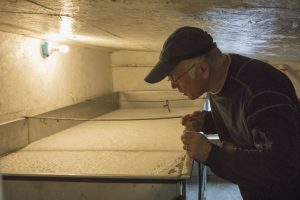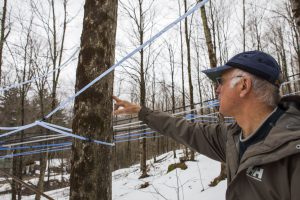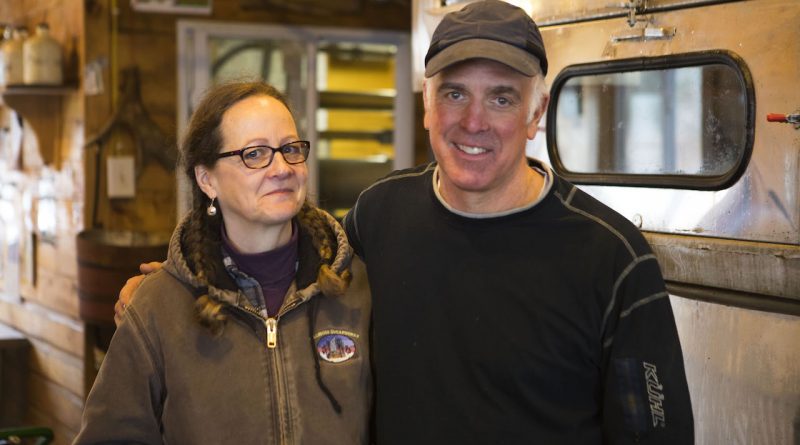Maple Sugaring: Vermont’s Canary in the Coal Mine
This article was originally published in the Addison County Independent.
ADDISON COUNTY — Earlier this week, in the hills of Starksboro and Huntington, wind whipped audibly through Hillsboro Sugarworks’ 15,000 sugar maples. Light rain tapped on the roof of the 1979 sugarhouse and dripped onto the ground. Sue Folino, co-owner of the operation with her husband, Dave, eyed the quivering trees warily.
“It’s days like this that can rip the forest apart,” she said.
Although it’s been a good sugaring season for the Folinos so far, days characterized by unpredictably strong winds and uncharacteristically high temperatures cause the Folinos worry about climate change, and how it might affect sugarmaking in the years ahead.
“I’m worried about climate change already existing,” Dave said, sitting beside a hulking evaporator in the sugarhouse.
“We have huge downpours almost every summer that have the ability to cause erosion, or wash out roads, or do quite a bit of damage. The other thing that seems to be happening a lot more since, maybe the year 2000, is high, high winds, and a tremendous amount of wind damage. I think they’re the first warning shots already hitting us that didn’t used to occur as often.”
The Folinos are not alone. More than 50 percent of sugarmakers are concerned about climate change, according to a study by UVM Extension and SUNY’s College of Environmental Science and Forestry. Out of 252 survey respondents, 44 percent have seen increased wind damage to trees, 39 percent are tapping earlier, and 21 percent have seen a decline in the health of their maples. Experts identify temperature changes, severe weather events and damage from pests as the chief threats to one of Vermont’s iconic industries.
And the stakes are high: Vermont’s maple industry contributed over $300 million to the state’s economy in 2013, supporting between 2,735 and 3,169 full-time jobs, according to UVM’s Center for Rural Studies.
“It’s an iconic industry for Vermont, there’s no doubt about it,” said Mark Isselhardt, a maple specialist with UVM Extension. “It’s a growing industry. U.S. maple syrup production has been growing steadily since the late 1990s. More and more people are getting into it, and people are getting into it at a larger scale. The product is being sold not just regionally, but globally now.
“If anything were to impact the ability to produce syrup, that could hurt more businesses that are devoted to maple production. There’s no doubt about that.”
But what happens when Vermont’s most iconic industry relies on tiny fluctuations in temperature — fluctuations that might become less predictable in the foreseeable future?
Most Vermonters know the routine: maple sap begins to flow during spring’s delicate balance of below-freezing nights, when water is drawn up into the stem of maple trees, charging it with sugar and potential energy, and above-freezing days, when trees thaw and sap is released by gravity. Historically, producers have come to expect the process to begin around Town Meeting Day — the first week of March. In the past decade at least, that has changed.
This year some commercial producers began tapping in early January, and aside from a mostly-frozen March, temperatures have peaked and plummeted enough to keep sap flowing. Given the longer season, it seems that Vermont’s climate is teetering on a sugaring sweet spot.
“We made syrup in January this year,” said Tom Gadhue, owner of Solar Sweet Maple Farm, which has 23,300 taps in South Lincoln. “We have not done that before.”
The Folinos started tapping the third week of January, and saw sap running in February. “That’s the earliest we’ve ever boiled,” Dave Folino said.
Last year’s record-high temperatures, which meteorologists say was fueled by the El Niño weather pattern in the Pacific Ocean, kept the sap running all spring long and helped Vermont produce a record amount of maple syrup. Producers milked a total of 1.99 million gallons from the state’s maple trees, to churn out a total of 47.3 percent of the nation’s maple syrup.
UNPREDICTABLE
Right now, warmer temperatures might seem like a benefit to sugarmakers, but as climate change
continues to push unpredictable weather, strong storms and warming trends, producing maple syrup may become more difficult.
“All farmers have some level of concern about weather and climate,” Isselhardt said. “If you’re growing a crop that takes all summer to mature, as long as there isn’t anything — a weather event — that’s completely devastating, you can usually ride out the variability.
“Sugaring happens at a very compressed period of time, four to six weeks, by and large. There comes a point at which, when you start losing days for one reason or another, they’re not coming back.”
Looking to the future, one concern, Isselhardt says, is that early temperature spikes will hinder the total crop yield. The reason for this is twofold. First, high temperatures signal sugar maples to begin developing buds, taking energy away from sap production. Once buds begin to develop, the syrup produces an undesirable taste, forcing producers to close up shop for the season.
Second, sugar maples heal wounds more quickly in warmer temperatures, which could cause tap holes to restrict or close earlier in the season.
“There’s a period of time at which a tap hole can be viable,” Isselhardt said. “The tree actually devotes energy to walling off the tissue to prevent infection. When it’s cold out, that wound response isn’t quite as rapid. Once it starts to get warmer, you get trees’ wound response, plus you get things — microbes — growing in the tap hole. There’s a nice sugary liquid in there, and things will multiply quickly. Some of that microbial growth will start to develop a gummy material, which will plug up the vessels. That will also reduce sap flow to the point where it’s no longer possible to collect sap.”
Concerns about microbial buildup can be mitigated with the use of a vacuum system — a machine that literally sucks sap from the trees through plastic tubing. As long as the vacuum is activated and pulling for the entire duration of the sugaring season, it will prevent microbes from piling up.
Vacuum tubing also protects against changes in freeze-thaw periods. Sap runs most plentifully during 45-degree days that follow 20-degree nights. Without the physical pressure caused by dramatic temperature swings, sap won’t gush in high quantities from the trees — unless it’s triggered by a vacuum.
So a warming climate could hurt those who gather sap by buckets more than those using tubing and a vacuum system.
“You still need to have some freezing and thawing to initiate that flow, but (with a vacuum system) you could have many, many days without a freeze,” Isselhardt said. “Bucket producers won’t collect any sap, but the vacuum will still maintain some yield.”
BUGS ON TREES
Pests are another concern. The forest tent caterpillar, a native species in Vermont, broke out by the millions in June of 2016, destroying the leaves of sugar maples in northwestern Vermont. Landscapes that should have been vibrant and green were a sickly brown — caterpillars left nothing but the veins of the leaves in their wake.
Right now, outbreaks of forest tent caterpillar occur every 15 to 20 years, but Isselhardt says these outbreaks might become more common with warmer temperatures.
“Forest tent caterpillar is a defoliator, so they chew on the leaves, and obviously the leaves are what give the tree its capacity to produce food,” Isselhardt said. “If you have defoliations happening more frequently, it could put the trees’ overall storage of carbohydrates in a negative trend, and it could hurt the overall health and vigor of individuals.”
And it’s not just native species that cause concern; warmer weather could mean more species of pests new to Vermont.
The Asian Longhorned Beetle, native to China and the Korean Peninsula, favors sugar maples and has no native predators to keep it in check. While the beetle has not yet infested Vermont, it has been found in several areas of New York.

“They can do quite a bit of damage,” Isselhardt said. “The larvae will feed throughout the stem and cause big issues, and eventually kill or damage the tree. They’re also hard to detect, for the most part, so they could go undetected for a long period of time, and the population could grow.”
Sugarmakers can ward off damage from pests by maintaining a healthy — and diverse — sugarbush. According to a study by the Northeastern States Research Cooperative, sugarbushes with 25 percent non-maple species were significantly less likely to be damaged by insect and disease pests.
Folino, who saw his sugarbush recover from a forest tent caterpillar infestation a decade ago, said an attack by Asian Longhorn Beetles would be a bigger threat.
“That kind of thing, if it happens, would be completely devastating, and you can’t control it by leaving a few other species in your woods,” he said.
‘GOLDILOCKS’ TREE
Though sugar maples are resilient trees, Isselhardt notes that preparing them for stress — from pests, temperature increases or extreme weather events — could improve long-term health.
“I think, what it comes down to, is that the forest is a competition,” he said. “They’re competing for light, competing for water, competing for nutrients. Sugar maple is really well adapted to our climate right here. If that changes, it may not be as well adapted. It has a very narrow range of site characteristics, it likes it a little bit wet, but not too wet — it’s sometimes called a ‘Goldilocks’ tree for that reason. So it could be that sugar maple finds itself in a climate that it can’t compete in quite as well compared to other species.”
Isselhardt works full-time researching and developing resources to create profitable and sustainable sugaring operations in Vermont. He encourages those with questions, concerns or suggestions to attend meetings and reach out to Extension staff.
Looking to the future, Folino acknowledges that a wounded maple industry could put a hole in Vermont’s identity.
“There’s the economic impact,” Folino said. “Increasingly in Vermont, with low dairy prices, maple has been one area where you could go and be profitable.
“But more important is the tradition within Vermont for maple,” he added, pointing to the fact that the U.S. Mint put a sugar maple on the back of the quarter representing Vermont. “That’s part of Vermont’s identity. It’s a lot bigger than just some hundreds of millions of dollars. It’s part of the cache of the state, the image of the state, the values and tradition of the state.”

